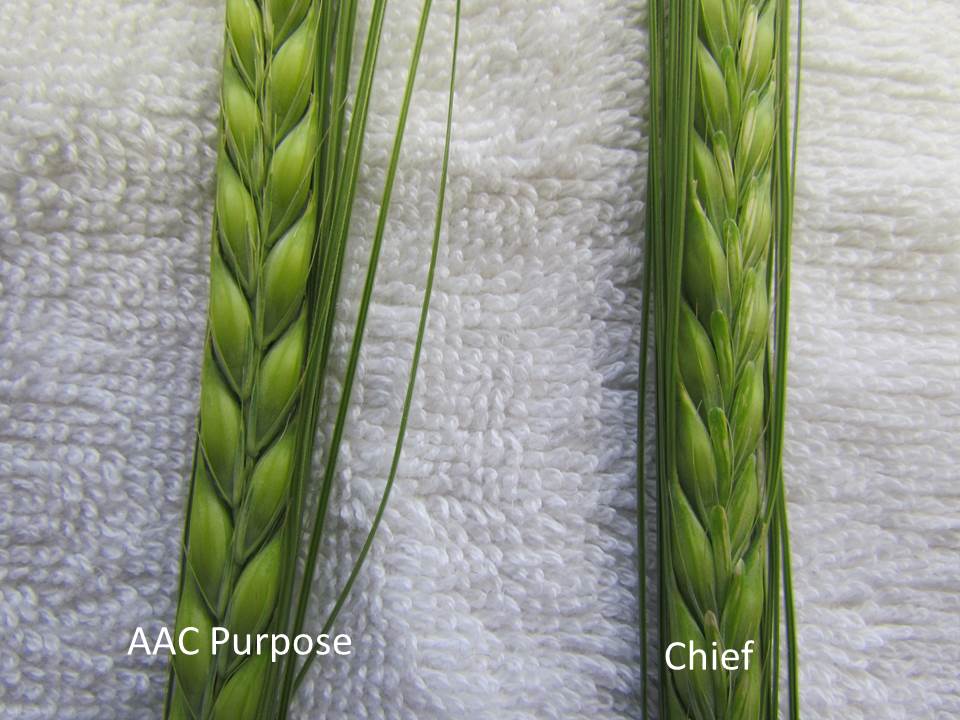AAC Purpose
| Denomination: | 'AAC Purpose' |
|---|---|
| Previously Proposed Denomination: | 'CH2309-2' |
| Botanical Name: | Hordeum vulgare |
| Applicant/Holder: |
Agriculture & Agri-Food Canada, Ottawa Ottawa Research and Development Centre Room 1093A - 960 Carling Avenue Ottawa, Ontario K1A 0C6 Canada |
| Breeder: |
Thin-Meiw Choo, Agriculture & Agri-Food Canada, Ottawa, Ontario |
| Agent in Canada: |
Agriculture & Agri-Food Canada Office of Intellectual Property and Commercialization c/o Shannon Whyte 107 Science Place Saskatoon, Saskatchewan S7N 0X2 Canada Tel: (204) 999-9887 |
| Application Date: | 2014-05-02 |
| Application Number: | 14-8298 |
| Grant of Rights Date: | 2016-11-08 |
| Certificate Number: | 5364 |
| Date rights surrendered: | 2023-11-08 |
Variety Description
Variety used for comparison: 'Chief'
Summary: The first segment of the rachis of 'AAC Purpose' is medium length while it is long for 'Chief'. The sterile spikelet of 'AAC Purpose' is absent while it is present for 'Chief'. The rachilla hair on the kernel of 'AAC Purpose' is long while it is short on the kernel of 'Chief'.
Description:
PLANT: two row, spring feed barley, spike emergence occurs mid-season
YOUNG PLANT: erect to semi-erect growth habit at tillering, absent or very sparse pubescence on lower leaf sheaths
FLAG LEAF (AT BOOTING): low frequency of plants with recurved flag leaves, very sparse to sparse pubescence on blade
FLAG LEAF SHEATH: strong glaucosity, very sparse to sparse pubescence
AURICLES: strong intensity of anthocyanin colouration, very sparse to sparse pubescence on margins
SPIKE: very weak to weak glaucosity, semi-erect attitude, v-shaped collar, parallel sided shape, very lax to lax density, sterile spikelet absent, glume and awn of the median spikelet are equal to length of grain
LEMMA AWNS: very weak intensity of anthocyanin colouration of the tips, longer than length of spike, rough spiculations on margins
FIRST SEGMENT OF RACHIS: medium length, weak curvature
KERNEL: whitish aleurone layer, long rachilla hairs, husk present, weak anthocyanin colouration of nerves of lemma, absent or very weak spiculation of inner lateral nerves of dorsal side of lemma, hairiness of ventral furrow absent, clasping disposition of lodicules, horseshoe shape of basal markings, medium length and width
AGRONOMIC CHARACTERISTICS: fair resistance to lodging, poor malting quality
DISEASE REACTION: susceptible to Fusarium Head Blight (Fusarium graminearum)
Origin & Breeding History: 'AAC Purpose' (experimental designation 'CH2309-2') was developed from the cross of 'Danuta' / 'Chief' made in the fall of 2002 in a Charlottetown, Prince Edward Island, Canada. The F1 to F6 generations were grown in a field at Harrington in 2002 to 2008. Selection was conducted for superior heads in the F4 generation and for superior lines in F5 and F6. One of the F4-derived F7 lines, 'CH2309-2', was tested in a preliminary test at Harrington in 2009 and in the Maritime Two-Row Barley Screening Test in 2010. From 2011 to 2013, 'CH2309-2' was tested in the Maritime and the Quebec Two-Row Barley Registration and Recommendation Tests. 'AAC Purpose' was selected due to its grain yield, head type and lodging resistance.
Tests & Trials: The comparative trials for 'AAC Purpose' were conducted during the 2014 and 2015 growing seasons at the Agriculture and Agri-Food Canada Eastern Cereal Oilseed Research Centre on the Central Experimental Farm in Ottawa, Ontario, Canada. In 2014, varieties were planted side by side along 30 metre rows spaced 0.18 metres apart in a plot measuring 404.7 metre square. In 2015, plots consisted of 4 rows with a row length of 4.1 metres and a row spacing of 0.23 metres. There were 4 replicates arranged in an RCB design. In 2015, measured characteristics were based on 20 measurements per variety.
Click on image for larger view

Barley: 'AAC Purpose' (left) with reference variety 'Chief' (right)
Click on image for larger view

Barley: 'AAC Purpose' (left) with reference variety 'Chief' (right)
- Date modified: